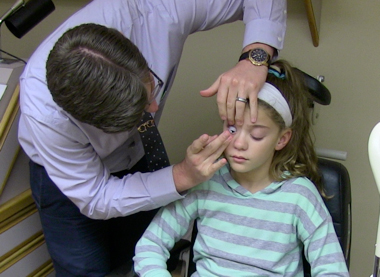 |
|
As overwear or improper cleaning of contact lenses can lead to adverse events, kids need clear instructions on proper use and parents should be vigilant toward adherence. Still, most children can safely wear contact lenses, this scoping review found. Photo: Jeffrey J. Walline, OD. Click image to enlarge. |
With contact lens wear increasingly being used as a method to slow myopia progression, the modality is becoming more popular in the pediatric population at younger ages than have been common in the past. Information on the safety profile of contact lens wear in young kids is limited, however. As such, it is important to characterize current understanding of contact lens safety in children as well as promoting safe and effective use.
A recent scoping review conducted for this purpose evaluated literature on safety of contact lenses in pediatric populations. A total of 73 studies across 10 countries within the last 40 years were included in the investigation using different lens modalities of orthokeratology (ortho-K) and soft contact lenses in kids aged six to 18.
The most commonly reported adverse effect of lens use in kids was corneal staining, but as this study’s lead investigator, Erin Tomiyama, OD, PhD, explains, “there was no uniformity in the reporting of these adverse events (i.e., type, extent, grade of staining) and often adverse events were not mentioned at all (excluding 127 studies).”
In the review, published earlier this week in Optometry & Vision Science, the authors note that far fewer studies examine safety of contact lenses in children than in adults; however, the ones that do report lower occurrence rates of adverse events in younger kids than older kids and adults.
Further discussed in the review are the most common adverse events by type of study conducted. Most common in randomized controlled trials were corneal staining and punctate keratitis, both of which were usually considered mild; only six of 29 randomized controlled trials looked at microbial keratitis, with four of the six reporting no cases. What’s more, eight of all randomized trials reported the outcome of infiltrative keratitis (zero cases in one study).
Retrospectively designed studies reported microbial keratitis in three out of 20 total included, two of three reporting no cases, while six retrospective studies reported the outcome of infiltrative keratitis; corneal staining was the most common adverse event in those studies.
Lens use discontinuation occurred in 24% of soft contact lens and 36% of ortho-K studies due to lens-related adverse events. Ortho-k based studies had a notable prevalence of adverse events with the most common being corneal staining and punctate keratitis. For soft lenses, these were corneal staining and infiltrative keratitis.
Despite these findings, the safety profile of both lens modalities is acceptable, with common adverse events mostly found to be only mild or moderately severe,. Related to this, the authors convey that, “given the recent advocacy for myopia control contact lenses, these findings perhaps underscore the importance of individualized fitting, proper training, close follow-up, thorough patient education and monitoring to enhance comfort and compliance and minimize risks.”
“However,” the paper continues, “the high incidence of corneal staining (a common occurrence in any contact lens wearers) aligns with previous reports of adverse events with both orthokeratology and soft contact lenses that warrant attention and suggest the need for ongoing monitoring and mitigation strategies to minimize discontinuation of lens wear.”
Elaborating on the work, Dr. Tomiyama highlights the clinical implications of these findings, suggesting that, “though we understand that there is a low-level risk for microbial keratitis from other studies, it would be helpful for clinicians to understand the risk of other adverse events to monitor for in their pediatric patients. Additionally, it would be helpful for parents to understand the level of risk with contact lens wear so they can weigh that against the benefits, such as improvement in child’s self-perception, vision correction and myopia management.”
Tomiyama ES, Kobia-Acquah E, Ansari SM, et al. Scoping review: reporting characteristics for the safety of contact lenses in the pediatric population. Optom Vis Sci. July 1, 2024. [Epub ahead of print]. |


